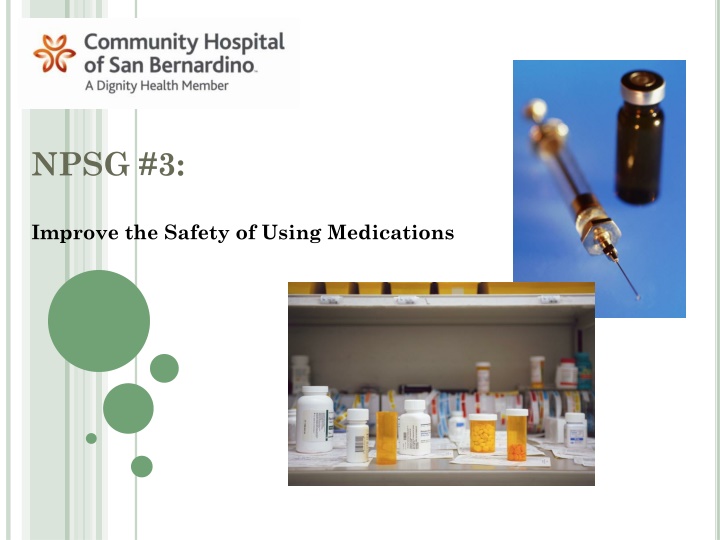
Enhancing Medication Safety in Healthcare Settings
Improve the safety of using medications through proper labeling and reconciliation processes in perioperative and procedural settings. Learn why medication reconciliation is crucial for patient care and who can carry out the reconciliation process. Understand the admission and transfer processes to ensure accurate medication management across different levels of care.
Download Presentation

Please find below an Image/Link to download the presentation.
The content on the website is provided AS IS for your information and personal use only. It may not be sold, licensed, or shared on other websites without obtaining consent from the author. If you encounter any issues during the download, it is possible that the publisher has removed the file from their server.
You are allowed to download the files provided on this website for personal or commercial use, subject to the condition that they are used lawfully. All files are the property of their respective owners.
The content on the website is provided AS IS for your information and personal use only. It may not be sold, licensed, or shared on other websites without obtaining consent from the author.
E N D
Presentation Transcript
NPSG #3: Improve the Safety of Using Medications
LABELINGOF MEDICATIONS For Perioperative and other Procedural Settings (Includes Bedside Procedures) sterilelabels1b Label ALL syringes, medicine cups and basins Labeling occurs AFTER the medication is transferred to the syringe of other container NEVER PRELABEL EMPTY SYRINGES OR BASINS Label Includes: Medication Name Strength Quantity Diluent & Volume Preparation Date
Labeling of Medications For Perioperative and other Procedural Settings (Includes Bedside Procedures) Visual and Verbal Verification Required if the container is handed off to another person to administer or at break/shift relief Discard any unlabeled containers immediately!
MEDICATION RECONCILIATION From The Beginning To The End
WHY DO WE RECONCILE MEDICATIONS? To accurately and completely reconcile medications across the continuum of care To reduce the risk of transition related adverse drug events To correct any discrepancies that are identified while the patient is in the hospital
WHOCANDOTHERECONCILIATIONPROCESS? The nurse or physician can do the reconciliation process
ADMISSION PROCESS Obtain list of medications from patient Document on Medication Reconciliation Module Call Physician and reconcile medication Print Medication Reconciliation and sign that you have reconciled with the physician Place Medication Reconciliation in the chart Medications listed on the Medication Reconciliation will auto populate on the Medication Transfer Form
TRANSFER PROCESSTOA HIGHER/LOWER LEVELOF CARE When a patient is being transferred to another unit use the Medication Transfer Form Call the physician and reconcile the medications on the Medication Transfer Form prior to transferring the patient Place an Y or N to indicate whether or not the current medication will be ordered and continued upon transfer The receiving unit will scan the Medication Transfer Form to the pharmacy
TRANSFER PROCESSTO SURGERY When a patient is being transferred to surgery Place a copy of the Medication Transfer Form in the chart prior to sending the patient to surgery After surgery the surgeon will reconcile all medications using the Medication Transfer Form Place an Y or N to indicate whether or not the current medication will be ordered and continued upon transfer
DISCHARGE HOME PROCESS New medications will be listed on the Discharge Instructions The patient will get a copy of their discharge instructions and the medication reconciliation form Provide education on medication management to the patient and or family
MEDICATION LISTTOTHENEXT CARE PROVIDER A copy of the discharge instructions and medication reconciliation form will be given to the patient and or family to take to the next care provider We no longer fax to the next care provider
DOCUMENTATIONOF REFUSAL OF MEDICATIONS
DIFFERENCEBETWEENAREFUSED MEDICATIONVS. A HELDMEDICATION A Refused medication is one that the patient refuses to be administered A Held medication is one that is not administered due to: A hold parameter BP medications (BP to low) Insulin (Blood sugar is too low) Patient is off the unit for a procedure
WHENTOUSETHEHOLD ACKNOWLEDGE FUNCTIONONTHEEMAR Use only when there is a problem with the order that you are acknowledging For Example: Incorrect dose or frequency entered Missing PRN indication This function is not to be used for held meds If a medication is to be held, document it in the eMAR on the designated time of administration If a medication is being held because the patient is off the unit but still needs to be administered, document it only when given. It will be RED on the eMAR but you can type your reason in the comment section
HOWTOPROPERLYDOCUMENTAREFUSAL OFMEDICATIONSONTHEEMAR Document Medication as Not Given Select REFUSED from drop down menu
OPENTHETEXT BOXAND DOCUMENTTHATTHE PATIENTWASEDUCATEDREGARDINGTHEREFUSAL OFMEDICATIONS
THEDOSEWILLBESHADEDWITHAGREYBOX INDICATINGITWASDOCUMENTEDAGAINSTBUTNOT GIVEN Document in the Nurses Notes when you notify the Physician
EXAMPLEOFHOWITAPPEARSIN MEDITECH USING PRINTORDER (PO)
